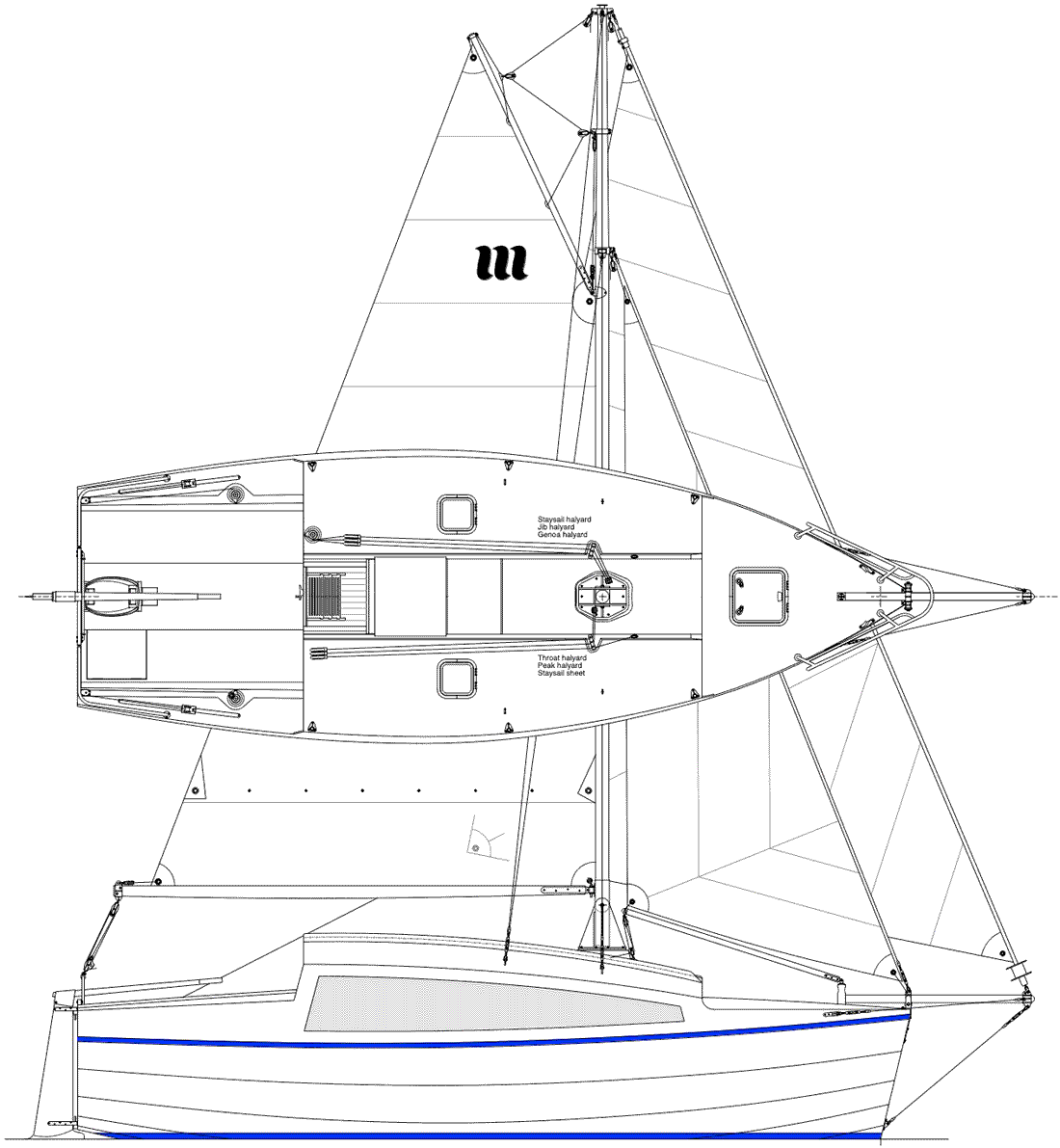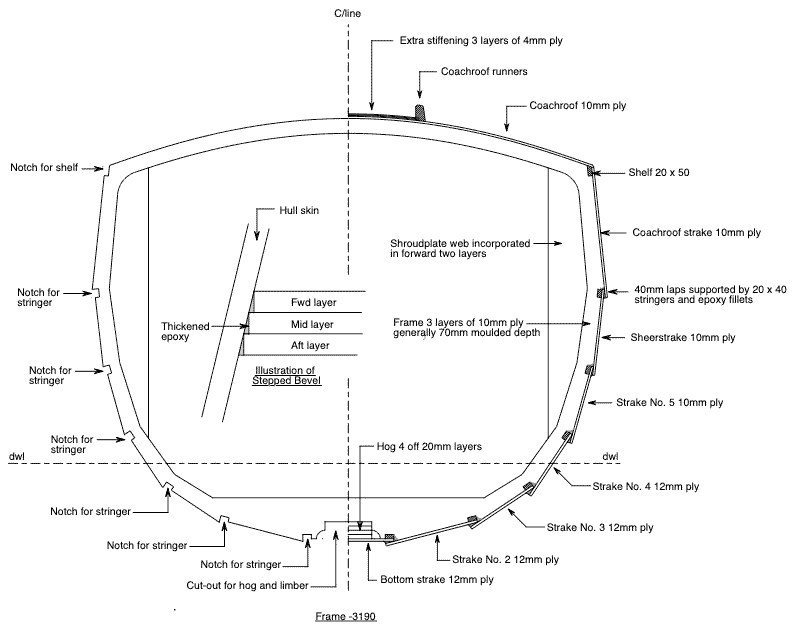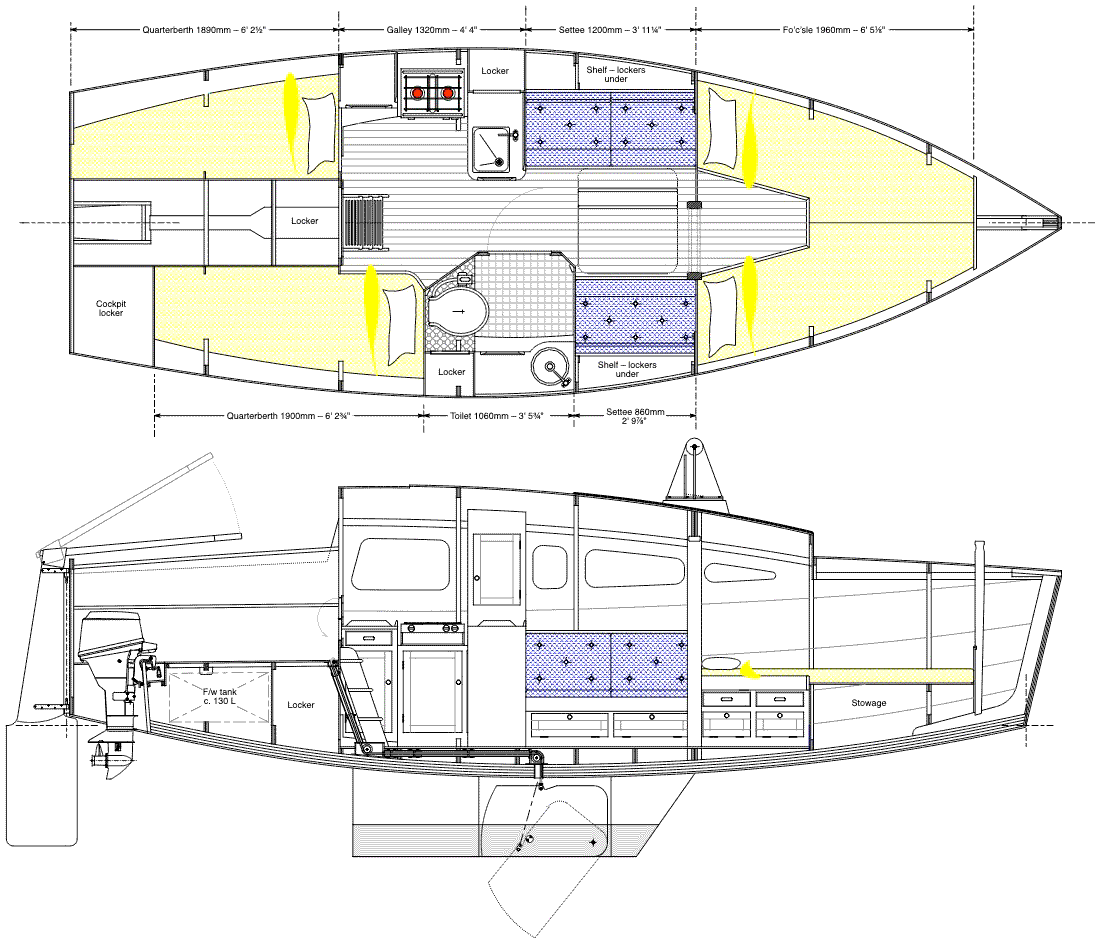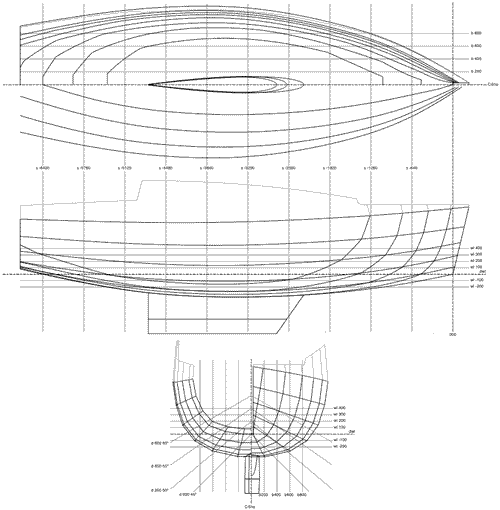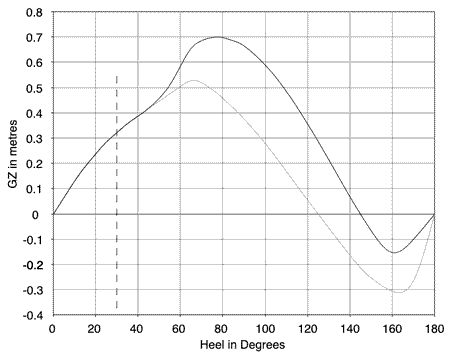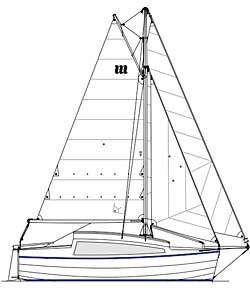| Specification | ||
|---|---|---|
| LOA (inc. bowsprit) | 8.045m | 26'4¾" |
| LoD | 7.000 m | 22'11¾" |
| LWL | 6.400m | 21'0" |
| Beam | 2.500m | 8'2½" |
| Draft (board up) | 0.925m | 3'0⅜" |
| Draft (board down) | 1.500m | 4'11" |
| Headroom (galley) | 1.835m | 6'0¼" |
| Headroom (toilet) | 1.780m | 5'10" |
| Headroom (saloon) | 1.765m | 5'9½" |
| Headroom (fo’c’sle) | 1.580m | 5'2¼" |
| Displacement on dwl | 2180kg | 4806lbs |
| Ballast | 900kg | 1984lbs |
| I | 8.240 m | 27'0⅜" |
| J | 3.520m | 11'6½" |
| P | 4.870m | 15'11¾" |
| E | 3.740m | 12'3¼" |
| 100% Foretriangle | 14.500m² | 156.0ft² |
| Mainsail | 15.750m² | 169.5ft² |
| Roller Jib | 16.300m² | 175.5ft² |
| Staysail | 6.000m² | 64.5ft² |
| Outboard Engine | 5-11kw | 7-15hp |
| EU Category B - Offshore | ||
Design No. 178 – Starfire 23: 7.000m (22'11⅝") gaff cutter
The Starfire 23 is a strongly built, robust, modern-style gaff cutter, designed for very straightforward construction in ply and epoxy. She is especially suitable for CNC cut parts, but all the data (including the shapes of developed surfaces such as the hull planks) is provided for builders to mark out and cut their own parts. No laying off (lofting) or spiling (taking shapes from the hull) is required.The hull is designed for lapstrake construction You can click here for a more detailed discussion of the construction of the boat. – a fairly narrow flat bottom strake with five hull strakes and a full-length coachroof strake.
The seven frames are made from three layers of 10mm ply and the outer edges are shaped exactly so that the strakes will fit directly to them without further shaping or bevelling of the frame edges.
The full-width coachroof gives us the possibility of a spacious accommodation extending out to the full beam of the hull. It also simplifies the construction considerably, obviating the need for the sidedecks, carlings and coamings.
The accommodation that we are showing here is a classic four-berth layout: twin V-berths in the fo’c’sle and a quarterberth each side aft under the cockpit seats. But several other interior layouts could be considered.
As noted above, the standard accommodation has two full-size V-berths forward; there can be a door to the fo’c’sle if more privacy is required. There are good drawers and lockers under the berths, with longer-term stowage under the forward part. Though we haven't drawn them, there could be nets or shelves above the berths along the hull for day-to-day clothes stowage. The standard accommodation is shown below – clicking the image will load a larger version together with a profile view of the interior.
The saloon, immediately aft of the fo’c’sle has a settee either side and a drop-leaf table, set over to port to allow a clear passage forward. There are drop-down locker fronts under the settees, with further stowage behind the seat backrests.
To port, there is a good-sized galley with a sink on the peninsula unit and a twin-burner & grill cooker along the hull side. There are excellent lockers under the peninsula and the hull-side unit, with a further locker outboard of the peninsula. The aftermost galley unit is set outboard a little to give better access to the quarterberth.
To starboard, the toilet compartment is set further forward than the galley to allow a good entry to the starboard quarterberth. The toilet compartment has space for a traditional marine toilet, a “Portapotti” style toilet or a composting toilet. There is a good locker outboard of the toilet. The washbasin is set in a worktop with lockers beneath.
Full-size quarterberths to port and starboard complete the interior accommodation. The starboard berth is probably the better berth, being rather more open at the head. Both berths have access to lockers under the cockpit sole, astern of the companionway ladder.
A complete General Arrangement Plan is available hereThe plan is a large PDF file and opens in a new window.
The rig as shown is a gaff cutter with a high peaked gaff main, a self-tacking staysail set on a club boom, and a roller furling/reefing genoa/jib. As can be seen on the deck plan the halyards and lines, including the staysail sheet, are brought back to the cockpit, with the genoa sheets turning to winches on the cockpit coamings. If wished, the main could be arranged with a one-line slab reefing system and those lines also brought back to the cockpit – one-lines systems do need careful attention to the leads on the boom to keep friction to a minimum. And, to further ease control of the rig from the cockpit, a lazy jack system would be effective in containing the main as it is lowered. With a reefed main and staysail (genoa fully furled), you have a very snug, easily controlled rig for heavier weather.
The Starfire 23 is shown with a fairly shallow keel and centreboard – the centreboard being wholly contained within the keel. The keel itself consists of a timber fin with a lead ballast keel on the bottom. The centreboard lift rope runs through a custom fabricated fitting on the top of the backbone, which simply requires a hole bored in the backbone; thereafter the rope is led aft through stainless tubes joined by rubber (exhaust) hose connectors and clips to a second watertight fitting under the companionway steps, from which it leads up to the cockpit. An alternative is to turn the fitting on the backbone to port and lead the lift rope to a fitting under the aft end of the saloon table and then up a hollow post to exit on the coachroof top – in many ways this is a simpler system.
Increasing the draft to about 1400mm (4'7") would give a good fixed fin keel with no centreboard, which is of course much simpler to engineer. A cast iron fin would essentially bolt directly on the underside of the hull; alternatively the fin can consist of timber deadwoods with a lead ballast keel on the bottom. Both would give excellent performance.
This design will be available for purchase once we have completed the build plans.

